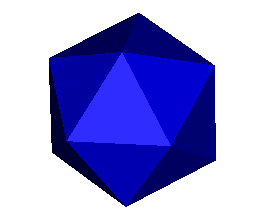
The net which generates an icosahedron, will also generate a number of other polyhedra. Each of these polyhedra is 'isomorphous' to the icosahedron. They each consist of twenty triangular faces, five of which are connected to each one of twelve vertices.
I recently attempted to generate and catalogue the isomorphs to the icosahedron. To my surprise there were a number of additional isomorphs in addition to the ones that I predicted. To my knowledge the total number of isomorphs is unknown.
'Semi-Regular' Isomorphs
The term 'semi-regular' is my own term for these and reflects the fact that they are derived from a regular polyhedron. The names of the semi-regular isomorphs are also of my own invention.
The most obvious isomorph
to the icosahedron can be obtained by inverting one of the vertices of
the regular icosahedron. I term this an inverted
icosahedron. Any other non-neighbouring vertex can also be inverted,
if this is opposite the first vertex I term the resultant polyhedron a
para-bi-inverted
icosahedron. The inversion of one of the five vertices surrounding
this opposite vertex results in a meta-bi-inverted
icosahedron. From this polyhedron a third vertex can be inverted
to generate a tri-inverted icosahedron. These four
polyhedra are shown below.
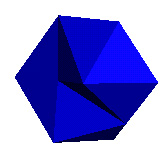
Inverted icosahedron |
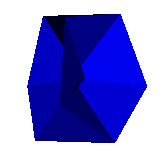
Meta-bi-inverted icosahedron |
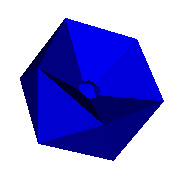
Para-bi-inverted icosahedron |
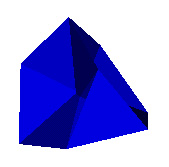
Tri-inverted icosahedron |
The great
icosahedron (above) is also isomorphous to the Icosahedron. A similar
process to that above can be performed. In these cases I term the adjusted
vertices as 'everted'. The result of this eversion is a pentagrammic
pyramid pointing out from the remainder of the polyhedron. As above, four
isomorphs can be produced: the everted great icosahedron,
the para-bi-everted great icosahedron, the meta-bi-everted
great icosahedron and the tri-everted great icosahedron.
These four polyhedra are shown below.
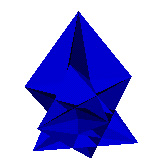
everted great icosahedron |
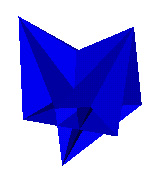
meta-bi-everted great icosahedron |
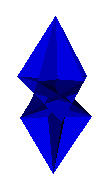
para-bi-everted great icosahedron |
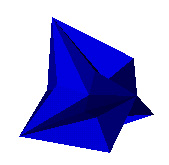
tri-everted great icosahedron |
Pentagrammic Anti-Prism
Three further isomorphs can
be produced starting from the base of a pentagrammic
anti-prism. Replace
the two pentagrammic faces with pentagrammic pyramids pointing out from
the anti-prism to generate a bi-everted pentagrammic
anti-prism. With both pyramids pointing inwards a a bi-inverted
pentagrammic anti-prism results. One pyramid can point each way
to form an everted-inverted pentagrammic anti-prism.
These three polyhedra are shown below.

bi-everted pentagrammic anti-prism |
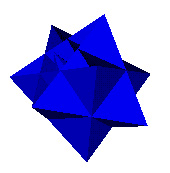
|
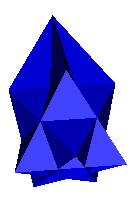
everted-inverted pentagrammic anti-prism |
Triangular Snub Anti-prisms
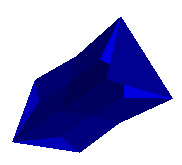 3/2 snub anti-prism |
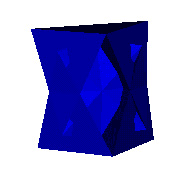 great 3/2 snub anti-prism |
The icosahedron is also the triangular member of an infinite family of prismatic 2-uniform polyhedra, the snub anti-prisms. As such, the various isomorphs to the snub anti-prisms can also be found in the isomorphs to the icosahedron. Above are two such examples, the 3/2 snub anti-prism and the great 3/2 snub anti-prism. The 3-3/2 hybrid snub anti-prism and the inverted triangular snub anti-prism also exist but we have already come across these in the guise of the tri-inverted icosahedron and the tri-everted great icosahedron respectively.
Other isomorphs
When I attempted to generate the isomorphs of the icosahedron, I imagined that the above polyhedra would be the complete set (I will admit that the snub anti-prisms were not in my original list). To my surprise a large number of other isomorphs were produced. One single run of HEDRON produced over eighty of these (discounting degenerate cases with superposed vertices or faces). They are difficult to categorise as they show a variety of starred, crossed and uncrossed vertices, and also show various degrees of symmetry. Some of the more interesting of these isomorphs are shown below, many are similar and some appear to be no more than random aggregations of triangles. Any suggestions on their categorisation or on the ennumeration of the total number of possible isomorphs would be welcomed.
One 'hint' as to the form of these 'other' isomorphs is that they appear to need each vertex to be non-regular. This supposition is made as an attempt to generate isomorphs with one vertex held regular by the insertion of a pentagonal or pentagrammic 'brace' inside the model resulted in only the 'semi-regular' isomorphs being formed.
With regard to the examples
below, note the relationship betweens examples 1
and 5 and , the similarity between examples 3
and 4.
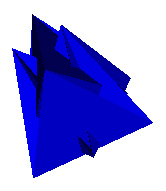
Example 1 |
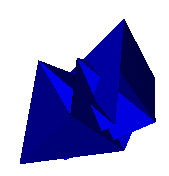
Example 2 |
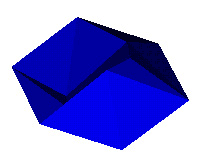 Example 3 |
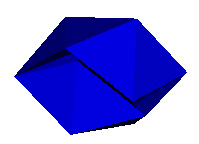
Example 4 |
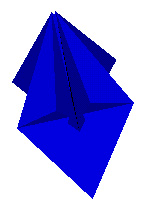
Example 5 |
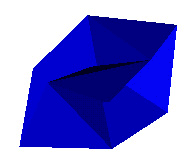
Example 6 |
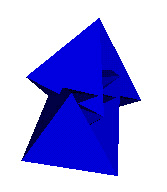
Example 7 |
Back: Main